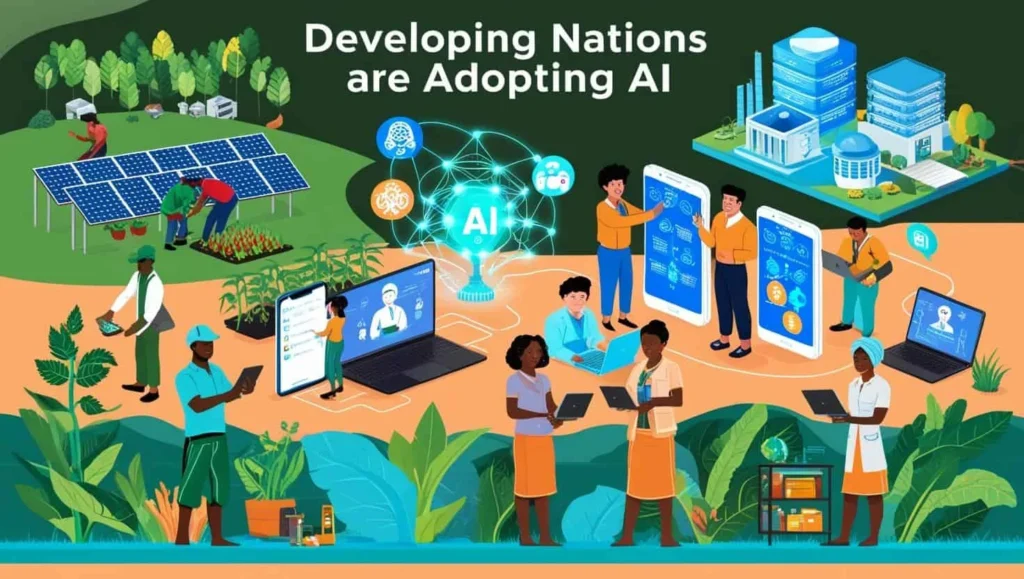Discover how developing nations are adopting AI in business—quietly transforming economies, boosting innovation, and closing the global tech gap.

Developing Countries Using Ai
Take yourself to a dusty road in Lagos, Nigeria. The sun was blazing, street vendors yelled prices, and somewhere in the chaos, a scrappy little logistics startup was quietly re-engineering its operations around artificial intelligence. No glamour of Silicon Valley-like offices. No massive funding rounds. Only one goal: Delivers goods faster using AI to predict traffic and optimize routes.
That is not some isolated story. It is happening all across the board. There is a quiet revolution from the sprawling Mumbai markets to far-flung farming villages in Kenya. A silent adoption of AI defines pragmatism, innovativeness, and human-centeredness in tackling problems in developing countries.
Why This Shift Matters Now
Now let’s get to the most apparent question: Why indeed should developing countries be getting into AI now?
It is not only the merry-go-round of the world. AI, for many of these nations, has proven itself beyond necessity. Gaps in infrastructure, inadequate skilled labor, and resource limitations all force businesses to start thinking out-of-the-box. AI need not be a luxury anymore. It is well within reach through open source tools and cloud-based platforms.
Think this through for a moment: for the countries lacking thousands of employees and gigantic call centers, automation through an ordinary customer service chatbot becomes practically essential, if not smart. But when an AI-enabled application can enable a farmer in Uganda to detect crop diseases early, it’s much more than just doing things differently-it’s a matter of surviving.
Real Stories, Real Impact
Let’s head for the Du Sahara. A garment factory on the outskirts of Dhaka had to wrestle with production delays and inventory losses. Old approaches clearly were not solving problems. So the management began using this AI-based analytics tool to predict demand and manage inventory. The result? A whacking 23% reduction in production downtime. In an industry where margins are already too thin, that’s a major boon.
Meanwhile, in the world of small-scale retailers across Latin America, AI is finding applications in the area of pricing and inventory management. For instance, in Colombia, AI would help shopkeepers forecast which products would sell faster in particular seasons. What in the past may have been guesswork is now giving way to data-based decision-making.
These are not the kinds of AI robots to grab headlines; these are systemic solutions to real-world problems that are subtle and effective.
The Tools They’re Using (and Why It Works)
So exactly how are they achieving this?
Mostly, it’s using cloud services – Google Cloud, AWS, and Microsoft Azure. Some of these platforms also provide free or affordable AI tools. Combine that with mobile apps, low-coding platforms, and open-source frameworks, such as TensorFlow or PyTorch, and the access barriers immensely drops.
But here’s the kicker: in many cases, these things will be much more transformational in developing countries because the ground is so much higher for improvement. The switch from notebook ledger to AI app would be immediate and obvious for a shopkeeper in Manila.
Overcoming the Challenges
Well, it isn’t all sunshine and smart machines.
The developing world has more hurdles to cross: issues like unreliable Internet connectivity, weak digital literacy in certain target groups, and inadequate regulatory frameworks. Yet, countries are quickly catching on. Governments in India, Brazil, and Rwanda have turned their attention to AI strategizing, digitization literacy campaigns, and startup accelerators.
The community is also chipping in. There is a caffeine acceleration of AI meetups and training hubs in Nairobi. Local entrepreneurs are connecting dot AI with local challenges. They understand the cultural context. They speak the language, and I do mean it literally.
Let’s Talk Ethics (Because It Matters)
Well, let’s get a little personal here.
What concerns me the most in all this growth is the possibility of bias. AI is only as good as the data it learns from. And when that data doesn’t mirror the diverse realities of the developing world, the consequences can be pretty damaging.
So it excites me greatly when startups take over the local actions. It is a great step forward when developers in Ghana model their language in either Twi or Yoruba or when Indian startups use their regional dialects to train AI: it only means innovation for empowerment.
What This Means for the Future of Global Business
Although this may sound a bit harsh, at least this is a real thought; disruption will not come from well-dressed tech campuses. Instead, look towards crowded urban streets, rural farmland, and dingy little mom-and-pop shops.
Developing countries are deploying AI not to impress anyone, but purely to solve everyday problems. And during those efforts, they are showing the rest of the world that you don’t need a trillion-dollar budget to develop smart solutions.
With the increased acceptance of AI, expect more leapfrogging. Just like several African countries skipped landline telephones for mobile, developing nations are skipping legacy systems and will pioneer AI-native business models.
Final Thoughts: The Takeaway You Shouldn’t Ignore
My challenge to the startup founders, investors, or policy-makers: stop looking at developing nations as passive recipients of technologies. Instead, see them as active creative problem-solvers.
Developing nations are adopting AI at their own pace and on their own terms. That’s what makes this revolution so powerful. It’s not too loud; very low-key. But it’s real, and it is happening.
The next time you hear someone say, “AI is only for rich countries,” send them this article. And remind them: revolutions don’t always start with fireworks. Sometimes, they start with one entrepreneur, and a Wi-Fi connection.

1 thought on “How Developing Nations Are Adopting AI in Business — A Silent Revolution”